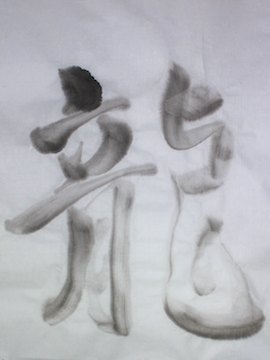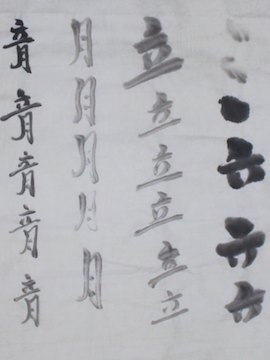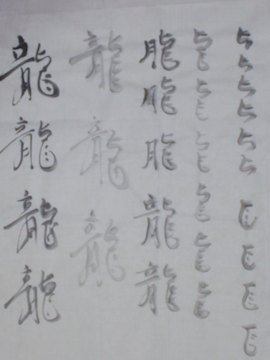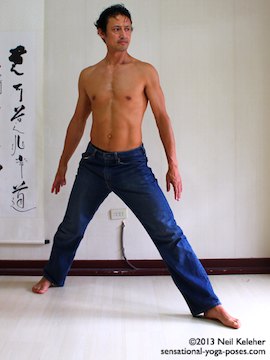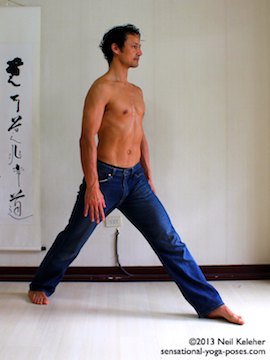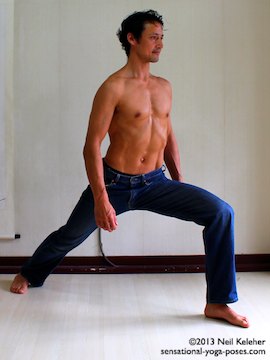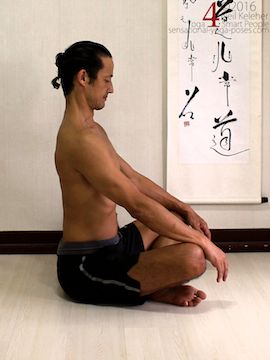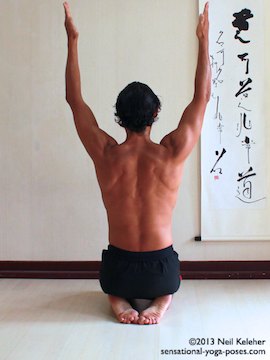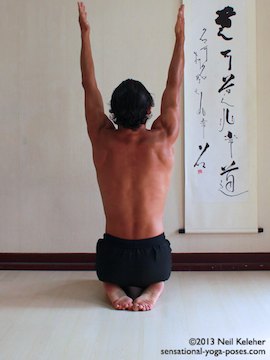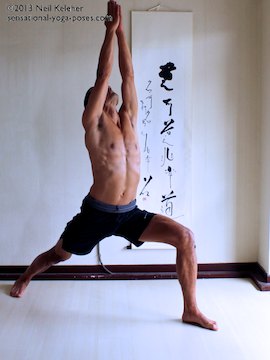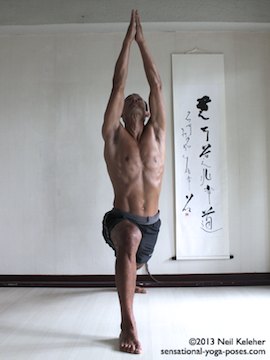Yoga Pose Brush Strokes
Tips for Breaking Yoga Poses down into Meaningful Elements For Improved Body Awareness, Coordination and Control
Chinese characters are much like yoga poses in that they are composed of many parts. And the idea is to connect those parts smoothly to each other. And when painting a series of characters, the idea can be the same, making one character flow smoothly into the next.
Rather than thinking about each brush stroke, the feeling is one of knowing each brush stroke and it can seem like the character is painting itself.
While learning, achieving this feeling of flowing can be difficult particularly when trying to pain a whole characters.
And so when I learn a new Chinese character I don't focus on trying to do the whole thing all at once. I break it down into elements and practice those elements in small groups.
The Chinese Character for Dragon has 16 Brush Strokes
As an example, the Chinese character for dragon (above right) has 16 strokes. Instead of trying to paint them all, I'll focus on only a few, say the first 5. I'll practice until they become smooth and then I'll add some more or focus on the next set of strokes in isolation.
In each of the pictures above, I was actually practicing from the top downwards and from right to left.
I'll pick a number of strokes that is easy to remember yet still challenging. I'll practice till I can do them without having to think. They won't be perfect but at least they'll be memorable which means that I can then add more strokes so that I can practice in a larger context.
The goal isn't perfection, it is remembering so that I can know, so that I don't have to think. Then with knowing repetition, then I get into the flow, then the brush strokes become more beautiful.
This idea can be applied easily to a set of yoga poses like sun salutations.
Learning The Yoga Pose Brush Strokes that Comprise a Sun Salutation
As an example, Sun Salutation A has 10 movements, 10 yoga pose brush strokes.
Rather than trying to remember them all I'll focus on the first few elements, say the arm raise (and lower.) I'll work on getting that till it feels good. That can mean spreading the shoulder blades first (to activate serratus anterior for scapular stability) then reaching the arms forwards and up while maintaining scapular awareness.
The return movement can be a slow and smooth relaxation of the previous movements.
Then I can focus on the forward bend. I can add this to the previous movements.
But if I have trouble, then I can focus on bending forwards and standing up without worrying about the arms, trying different techniques to see if I can make this movement more comfortable, more fluid. Then I can add the arm lift back in.
Likewise I can break out the brush stokes for Chaturanga Dandasana, up dog and down dog.
Finding little elements to practice, I can still retain the rhythmic feel of a sun salutation, however the repetition units are smaller. Rather than repeating ten brush strokes, I only repeat 3, 4 or 5 brush strokes. I find an element count that increase my learning but still feels good and doesn't require me to think while I am doing.
(The thinking is in deciding in what elements to practice.)
I then become familiar with each part of a sun salutation and then it is that much easier to join those yoga pose brush strokes into one complete sun salutation.
I can then focus on flowing from one part of the sun salute to the next without having to think.
Instead I can observe my body and make corrections or adjustments as I go.
Breaking Static Yoga Poses into Yoga Pose Brush Strokes
So what about a static yoga pose. How do we break that down into yoga pose brush strokes?
Well first of all a static yoga pose has to be entered into. And so one simple way to practice a static pose is moving in and out of it smoothly and slowly.
Often times moving in and out of a pose is more difficult than doing the pose itself. But the advantage of moving in and out of a yoga pose, particularly repeating a movement, is that it makes it easier to learn to feel your body and at the same time you also learn or develop better control.
Breaking Warrior 1 Down Into Its Yoga Pose Brush Strokes
Say the pose that you are learning is Warrior 1. How to break warrior 1 into yoga pose brush strokes or elements?
You could first focus on the legs and pelvis. Start with one leg back. Then the elements can be:
- square the pelvis to the front,
- bend the front knee,
- straighten the front knee,
- relax.
- Repeat.
When bending the front knee adjust the foot position first so that the shin is nearly vertical, then so that you can get your thigh horizontal while keeping the pelvis square.
Difficult yes, so do the best you can and work towards it. At least by slowly entering the pose and leaving it you don't have to hold the position which is a lot more difficult. Plus you can learnt to feel what is holding you back. Or you can slowly develop the awareness, strength and mobility that is required to hold the position.
Another yoga pose brush stroke would be the spine and making it long. You could practice this in isolation while sitting.
Then you could stand with legs straight, one leg back, and lift ribs away from pelvis and head away from ribcage. Then relax and repeat.
Then do the same thing with the front knee bent. Try to keep the pelvis at the same height. Stay aware of the front knee, keep it still so that you are actually lengthening your spine and not just lifting the pelvis higher to make it seem like you are taller.
And then you can add the arms. Here again you can practice the arm action while sitting.
Sitting with arms lifted and elbows bent, lengthen your neck, then lift your shoulders, then straighten elbows and fingers, then relax.
Adding these elements together you can square the hips, bend the knee, lengthen the spine, lengthen the arms, stand and relax. Repeat.
Or hold the knee bend and focus on lengthening the spine and arms, and then relaxing and repeating.
Eventually, over the course of days, weeks or months of practice you may find it feels more interesting to move beyond this step by step practice and instead just move into the pose and hold it while staying aware of your body and making adjustments as required while you hold the pose. Then the focus can be on creating maximum space with minimum effort.
Learn to see Relationships and Clearly Defined Changes
With Chinese characters it is fairly easy to see brush strokes. I use those as my basic elements either adding or subtracting brush strokes from what I am practicing until I find a practice unit that feels just right.
Even in grass style calligraphy, where the brush strokes are less obvious, I look for other things, changes in direction, corners, curves, crosses. I notice relationships and changes. And those are how I define my brush stroke elements.
And so with yoga poses and the body in general, the better you are at spotting relationships or changes the easier it is to create useful yoga pose brush strokes.
Want a good way to practice noticing relationships and changes, take a look at dance of shiva.
It is very similiar to calligraphy in that it is easy to break down the positions and movements into smaller elements.
And then once you've learned the elements you can also practice flowing without thinking.
If you practice being aware of relationships in dance of shiva, that awareness is very easy to transfer across to yoga poses so that you can break yoga poses down into yoga pose brush stroke elements.
But the yoga pose brush strokes aren't the end goal. Rather they are a means of becoming more mindful in the yoga pose as a whole.
Published: 2020 08 17
